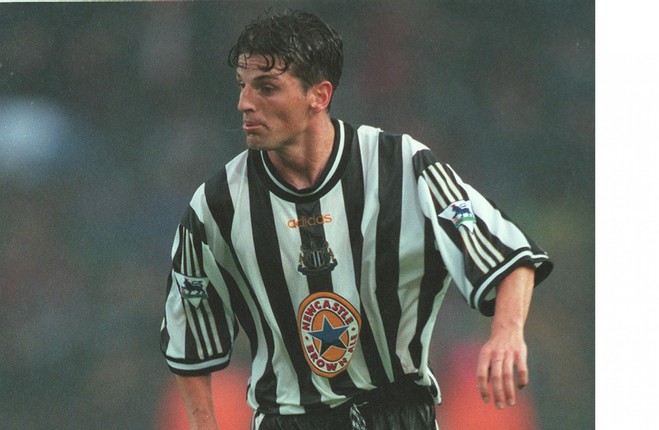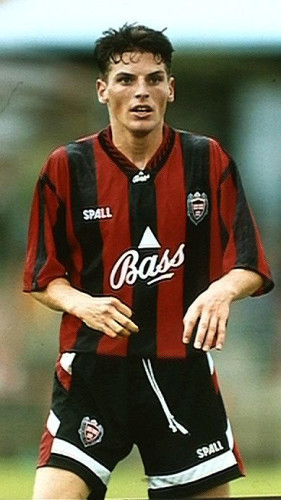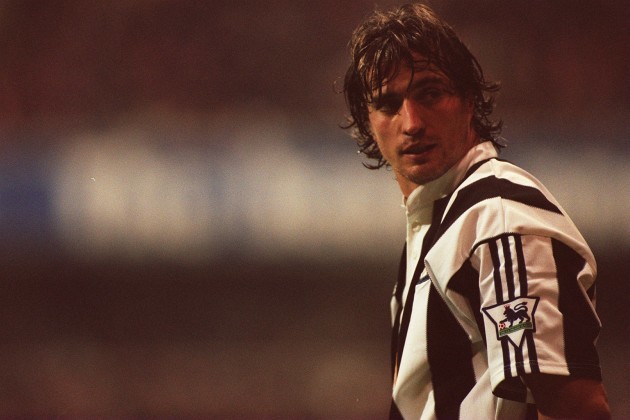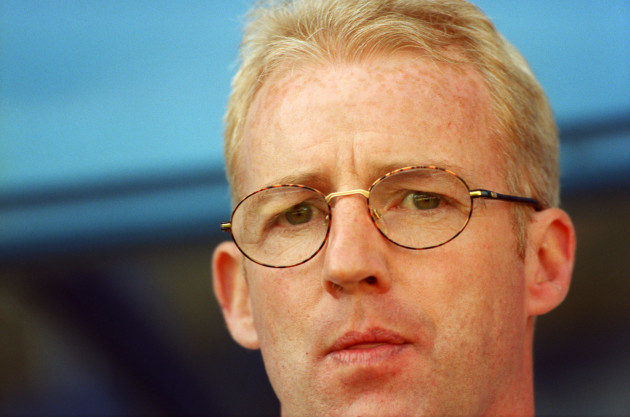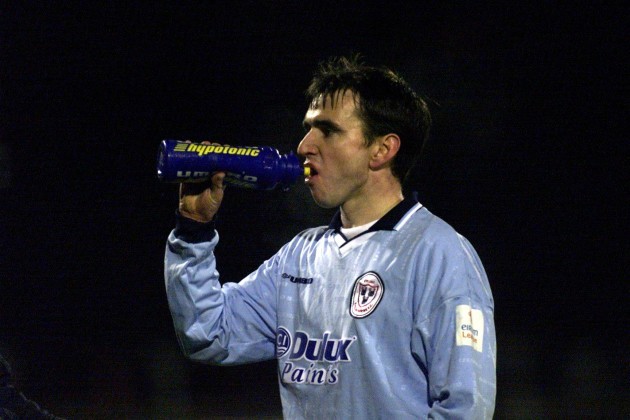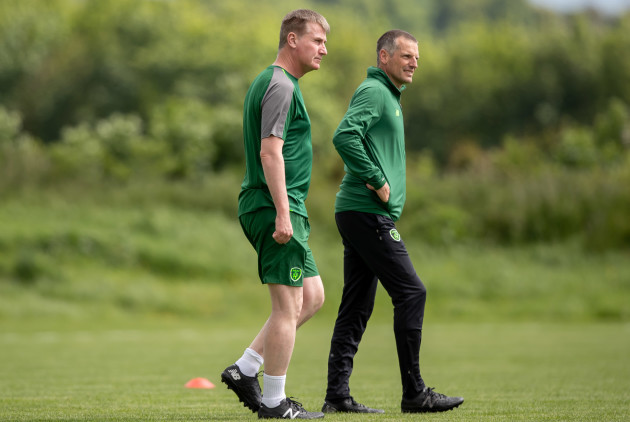IN THE PREMIER League’s history, the 1995-96 season is regarded by many people as the most exciting campaign since the competition’s onset.
In the awards to mark its 25th anniversary, the famous Liverpool 4-3 Newcastle match was voted the most exciting game English football has produced in that period.
The 3 April fixture was seen as a pivotal moment in that year’s title race. Newcastle, perceived as the great entertainers due to their incredible attacking prowess and tendency to be error-prone at the back, ultimately surrendered a 12-point lead and lost the title to a resurgent Manchester United.
Almost exactly a year before that remarkable Liverpool game, a highly promising Irish player made the move to the Magpies. His path there, however, was far from straightforward.
*******
Jim Crawford was born in Chicago, but always felt more Irish than American — he would later turn down an offer to declare for the US, preferring to play with the Boys in Green at U21 level. Both his parents were from Ireland, and when he was around eight or nine, the family moved back home.
It was not until Crawford moved to Dublin that he was introduced to football, having played baseball in the States. Before long, he joined Terenure-based side Rangers, who played their home games in Bushy Park.
Crawford was aware it was not necessarily the traditional path to stardom, with the majority of young Irish footballers starting out at better-known schoolboy clubs, such as Belvedere or Home Farm.
“The team I played with, we weren’t great,” he tells The42. “We were always in the second or third tier of schoolboy football.”
“I was always determined to get into what was then the A league… I put myself against those players that were playing A football week in week out. I knew all the names of the top players.
There weren’t any in my age that made it [in England]. A lot of them went to League of Ireland. But nobody went on to play in the Premier League.”
At that stage, Crawford was already immersed in football, both in terms of watching and playing.
“With Rangers, there were a few of us who used to go and mark Harold’s Cross football pitch, where Shelbourne used to play. On Saturday, I’d be helping to mark the pitch and on Sunday, I’d be ballboy. I had a real deep interest in League of Ireland then.”
And eventually, Crawford went from League of Ireland fan to player. A brother of one of his coaches at Rangers was a close friend of Eamonn Gregg, the Bohemians coach. He was invited down to train and ultimately signed for the Dublin side.
“I went from a team that weren’t really winning things at schoolboy level to paid players. The demands were high at Bohemians, even back in the ’90s. They were a big club. But I loved it. When I first started training with Bohs, there was Robbie Best, Paul Whelan [brother of Ronnie], Pat Fenlon, all these established players in the league that were superstars in my eyes.”
Still a teenager at the time, Crawford at first played only sporadically. A Dave Tilson goal saw Bohs beat Cork City to win the 1992 FAI Cup. Gregg got the youngster a medal, which he says “didn’t really mean anything to me,” owing to the fact that he had not played a single game in that year’s competition.
Crawford was involved the following year, however, as he got his first taste of European action during a match against Bordeaux in the Uefa Cup.
A young [21-year-old] Zidane played as well. In fairness, he ran the show and was a fantastic talent, even back then. One thing that stood out for me was he wasn’t a lot older than me, but he was a million miles away in terms of physicality, pace, vision. His ball control, his technique, he was phenomenal. I said, there’s a player now that will go on to bigger and better things and in fairness, he did. What a talent.”
Dutch international Richard Witschge and future World Cup winners Bixente Lizarazu and Christophe Dugarry also featured for the French side. The latter scored the only goal when the sides met in Dalymount Park, capitalising on a rare Robbie Best error that saw him concede possession in a dangerous area before the striker slotted the ball past goalkeeper Dave Henderson.
By his standards, Zidane had a quiet night in Dublin — he was replaced by Witschge on 69 minutes. The second leg was a different story, however, as the future Real Madrid star scored one and assisted another amid a comprehensive 5-0 win. Crawford came on for the final 14 minutes of that match in France, as he still had not established himself as a regular in the Bohs side.
Despite his status as a squad player though, Crawford was as heartbroken as the rest of the team on the final day of the 1992-93 season. All Bohs needed was a point up in Dundalk to win the league, which would have given the youngster his first winners’ medal. Yet a Tom McNulty goal handed the hosts a 1-0 victory. It meant the title would be decided by a three-team play-off involving the Gypsies, along with Cork and Shelbourne, all of whom had finished on the same number of points.
“We had a better goal difference than the other two,” Crawford recalls. “Had it been now, we would be league champions.
“We were devastated to lose to Dundalk in the manner in which we did. The bus broke down. It could have been an hour or so. We weren’t ready to play the game, because we didn’t even warm-up. It was just straight into the dressing room, we went out for about five minutes and the game was to start. It was disappointing and we had to get ourselves up again for this three-team play-off, which we weren’t great in.”
Cork ultimately sealed that year’s title at Bohs’ expense. And there was more disappointment the following season. With results poor midway through the campaign, Gregg departed as manager, with the Dublin side ultimately finishing an underwhelming sixth. On an individual level though, it was an important season for Crawford. He finally started to play consistently in the starting XI and his performances led to him being named the PFAI Young Player of the Year. Looking back, the former midfielder cites the faith shown in him by new manager Turlough O’Connor as key to his development.
“The very first training session, there’s a real good buzz about it, he came over to me and said: ‘How are things, Jim?’ I was shocked he knew my name.
On the Friday, we played Shamrock Rovers in the very first game. He just pulled me outside the dressing room and said: ‘You’re starting for me tonight in the middle of the park with Pat Fenlon.’ It was fantastic. Rovers were flying at the time and we won. It was a packed house and I got man of the match. From then, things just started to turn for me for the better.
“I had been so close to knocking on Eamonn Gregg’s door and saying: ‘Can I go out on loan?’ I didn’t want to leave Bohs, but I knew for my own development, I needed to play week in week out.
“I met [Turlough] when I signed my first contract. It wasn’t very much, but I wasn’t going to argue with him. He had me hook, line and sinker, because whatever he was going to offer me, I was going to sign anyway.”
It was not long before Crawford’s performances started to attract attention from across the water. Wolves, Stoke and Aston Villa were all interested, with Crawford going on trial to the latter, but deciding the feel of the club wasn’t right. He then travelled to Newcastle on trial in January and signed the following March. Bohs tried desperately to hold onto their man or at least get a better deal, but as the transfer deadline loomed, the £75,000 move was pushed through.
An Irish Press article from the time noted: “The level-headed young man from Jobstown is not being carried away by all the excitement of his dream move to Tyneside. He was at work yesterday at a sports goods shop in Bluebell, delighted to accept the messages of a posse of well-wishers.”
Andy Cole had left the Magpies for Manchester United the previous January and there was perhaps a sense that a more high-profile player would be brought in, rather than someone who was essentially unknown in Britain.
Crawford did not make an appearance in the remaining months of the 1994-95 season, and the difficulty of getting into the starting XI was underlined by a busy summer, with stars such as Les Ferdinand and David Ginola recruited by the club from QPR and PSG respectively.
“I remember I saw a highlights reel of [Ginola] scoring numerous fantastic goals. Pre-season back then, we did a lot of running, and he came last in all the long runs. We wondered: ‘What type of fella did we sign here?’ The goalkeepers would be coming in before him. But when the ball came out, he was on a different planet altogether. Unbelievable touch, vision, strength. Everybody just stood up when he got the ball in St James’ Park. They knew something magical was going to happen, whether it was a pass or a bit of trickery. I’ve seen so many full-backs falling for it, where he’d drop his shoulder and come inside. He could play off his left or right, no problem whatsoever. He was a genius on the ball and somebody I didn’t enjoy coming up against in training, that’s for sure.”
Another star signing arrived later in the form of idiosyncratic Colombia international Faustino Asprilla.
I remember one day, driving down to London with the TV on the coach. There was an interview on with Juninho, who had signed roughly the same time for Middlesbrough. He had fantastic English. We were saying: ‘How the hell can he speak fantastic English? And we’ve got a fella who could only curse in English.’ He was just such a laid-back fella, who didn’t really care. He came, played football, but in terms of learning the language or the English culture, he didn’t care.
“You just didn’t know what to expect from him. You wouldn’t even know he was there some days in training, he’d be that poor. But then you’d go and play on the Saturday and he’d be the standout player for unlocking doors against top defensive units. He was an unbelievable talent, but a headcase at the same time.”
This elaborate operation was overseen by former Liverpool and Newcastle star Kevin Keegan.
“Kevin was a great man-manager. I was on the bench more times than not, so I didn’t experience Kevin Keegan as a manager the way he would approach Rob Lee or Philippe Albert. I could see some sort of a distance, a little bit like Turlough O’Connor and me. But he got the best out of players. He was always chirpy. Always had the sessions buzzing. He got the players believing they were the best in the land. It was just unfortunate. We threw away a sizeable lead against Manchester United for them to go on and win the league. I think it hit Kevin hard and it hit the players hard to surrender such a commanding lead at Christmas time.
“He deserved big success at Newcastle. The way he went about his work was top class. The Newcastle public loved him. He always said the right things. I just wish Newcastle won the league.”
Crawford did ultimately play twice for Newcastle, including a 4-3 defeat to Liverpool — though not the one everyone instantly thinks of. Instead, it was a March 1997 match, by which point another Reds legend, Kenny Dalglish, had become the Magpies’ manager.
“I didn’t expect to come on, because I was on the bench quite a few times. We were 3-0 down. Les Ferdinand was an attacking throw of the dice. He came on, even though he was struggling with a hamstring. He didn’t last long at all. Kenny said: ‘Look Jim, just go on and play on the left side of midfield.’
“I think it was Steve McManaman [that I was up against], so it was a bit of a test for me. I played, did okay, we were 3-0 down, we got it back to 3-3. Liverpool should have been well out of sight. Had we got a point from the game, it would have been a travesty for Liverpool, because of the amount of possession they had and chances they created.
“One thing that does stand out is Robbie Fowler at the back post scoring an excellent header and the noise when it went in was deafening. It was one of those low points in your career where you’re coming on, what an amazing feat it would have been to come out of Anfield with a point. We dusted ourselves off and went on with it after that. It was a great experience being involved in a game of that capacity. It turned out to be one of the top Premier League games there’s ever been.”
Crawford played again five days later, replacing Ginola with 10 minutes remaining in a 4-0 win over Coventry. It would be his last appearance for the club.
Just when you started seeing a little bit of light, in comes David Batty. The pressure was always on. You had Lee Clark, who was a fantastic player. I’m looking at him saying: ‘Right Jim, that’s the level.’ Lee probably would have felt hard done by that Dave Batty went straight in, because Lee was playing exceptionally well at the time. Lee was on the bench and I’m looking at it then, going: ‘Right, Newcastle is probably too big of a club here and you have to go elsewhere.’
“Dalglish came [in January 1997], gave me a couple of games, pre-season I was definitely part of his plans with the first-team squad. But then I picked up another injury, and a dip in form, and eventually Kenny just brought me into his office and said: ‘Look, it’s best you move on for your own development.’
“It was something I was expecting, because you’re looking at the size of the squad, you’re not pulling up any trees. I had other coaches as well saying ‘you best move on’ and as much as I love Newcastle, the people there and this loyalty thing I always had that stems from Rangers, I just wanted to stay there, but my head ruled my heart. I said to myself: ‘You’ve just got to get out and get playing again, because you’re wasting away.’”
After loan spells at Rotherham and Dundee United, Crawford joined Reading permanently in 1998. Celtic legend Tommy Burns, who had worked with him as a coach at Newcastle, persuaded the player to join the Royals.
“The late, great Tommy Burns. With him, Turlough O’Connor, Kenny Dalglish, these are all people I learned so much from, not about specific drills, but how to deal with people the right way.
“Tommy was initially with the Newcastle reserves. I used to train with the first team. You’d start training at 10 o’clock and you’d be finished for the day at 11.30. Tommy said: ‘Once you’re finished with the first team, I want you to come out — we’re doing a double session with the reserves.’ I loved it.
“And there were other days where I was training with the reserves in the morning and in the afternoon. But to have someone who was focused on developing you as an individual footballer as well as a person [was great].
“He eventually went to Reading and brought me with him. Things didn’t work out for Tommy or myself, whether it was injuries or what have you.
[Burns' successor] Alan Pardew was honest enough saying: ‘Look, I’m going to bring in my own players.’ He was proved right, because he was very successful at Reading.”
In the summer of 2000, with his career at a crossroads once more, Crawford had offers from a number of sides to either join them or go on trial. Rotherham, Carlisle, Oxford and a few Conference teams were all interested, but in the end, he chose Shelbourne, after being persuaded by then-manager Dermot Keely.
“I just thought he was an impressive person,” Crawford says of Keely. “You look at his playing career, what he’d done as a manager at Shels the year before, I was definitely onboard. To this day, I felt like I didn’t give him what he expected.
“It’s not like today, where you’ve got sport scientists and more educated physiotherapists that can monitor training loads. Back then, as soon as the physio gives you the rub and you’re pain free, you’re playing high-intensity football again. I look back and say: ‘Yeah, that’s why I did break down a lot.’ I’d gather 2-4 games on the bounce and my hamstring or back would go again. I just felt I was on the treatment table far too much.”
Paul Doolin, Pat Fenlon, Pat Scully, Stephen Geoghegan, Declan Geoghegan and Owen Heary were all part of the club at the time.
In Crawford’s first season, Shelbourne suffered an even more dramatic title collapse than the Newcastle 1995-96 team. With eight games to go, they were 12 points clear at the top, only to be pipped to the title by Bohs on the final day.
“I was injured quite a lot. It wasn’t nice to be watching the games. But I played enough to grant me a medal had we won the league, but we didn’t. Cork came up to beat us on the day and Bohs went on to win the league. So that was another league that got away from me.
“The dressing room had split towards the second half of the season and it showed on the football pitch.
“Dermot did the right thing by getting rid of a couple of players. The culture then was one that had us all working extremely hard, but the pressure was on to get some silverware, but unfortunately he left for personal reasons.”
It wasn’t long, however, before Crawford and Shels started wracking up titles, triumphing in 2001-02, 2003, 2004 and 2006.
“Pat [Fenlon] inherited a really good group of players. When Dermot was in charge, there were about eight full-time footballers. When Pat came in, it wasn’t long before the whole squad was full-time.
The most enjoyable part of my football career would have been under Pat. The players that were involved that he brought in — Stuey Byrne, Jason Byrne. Then you have top-class players such as Wes Hoolahan and Joseph N’Do. And men like Dave Rogers, Colin Hawkins, Alan Reynolds. Pat had an eye for players, got the best out of them, and that’s why we were successful under his reign.”
There were also some memorable European nights. They held Deportivo — a team who had reached the previous season’s Champions League semi-finals — to a 0-0 draw in Lansdowne Road. In the second leg, Jason Byrne had a great chance to put Shels in the lead, but uncharacteristically failed to properly connect with the header, before the visitors ultimately ran out of steam and were beaten 3-0. Perhaps more than anything, it was a game where the scale of future Ireland international Wes Hoolahan’s talent became apparent.
“We were up against players like Juan Carlos Valeron and Albert Luque, but Wes was the best player, head and shoulders above everybody. That’s when I said to myself ‘he shouldn’t be here’. The selfish part of me was thinking ‘he should stay with us,’ because I wanted to win more trophies.”
Crawford was coming back from injury at the time, so he didn’t feature in the home Deportivo game, while he replaced Hoolahan with 21 minutes remaining of the second leg. He also featured in the subsequent Uefa Cup tie against Lille, whose side featured Milenko Acimovic, a talented Slovenia international, who had just joined following an underwhelming two-year spell at Tottenham.
“I thought they were a better team [than Deportivo]. They were 2-0 up and Glen Fitzpatrick came on and scored two great goals to make it 2-2. So it set up the second leg to be exciting. They didn’t have any household names. There was a boy, Acimovic, who used to play with Spurs. He gave me eight stitches. He caught me with an elbow in the game. They beat us very comfortably 2-0.”
The Shels experience would ultimately end in tears for Crawford and co. In 2006, the club ran into financial problems, and the players showed admirable character to win the league, despite going weeks without being paid on occasion.
“Of course the lads weren’t happy, but we came to an agreement. We could either go on strike, or we could give everything we have, win the league, and whatever happens after that happens.
“It was a bittersweet situation. Sweet, because you won a league again, but I think we all knew ‘this is it’. I certainly did.
Players went their separate ways unfortunately and it was very disappointing, because [the chairman] Ollie Byrne had a really successful schoolboy set-up. You had players like Anthony Stokes, Eoin Doyle, Gary Deegan, James Chambers. So the club was ahead of its time. Ollie was ahead of his time. The thing is with Ollie, he didn’t have a powerpoint presentation or a social media site to show what they had. Unfortunately, Ollie’s ideas would have been written on the back of a Shelbourne programme. But the vision was there to get a training ground and what have you, we just needed the financial backing.”
And when it all collapsed, Crawford was one of the few star players who stuck around initially.
“Dermot Keely came back and I went back as a part-time player then. I was very fortunate to land a job with the Football Association of Ireland, so I didn’t need full-time football. It was a chance to repay Dermot for having faith in me after coming back from England. And again, it didn’t happen. I was at the wrong end of my career and still picking up these niggly injuries. We finished mid table that year in the First Division. I had a dream of us going to win the league, but it wasn’t to be. After that, I met up with Liam Buckley about signing for Sporting Fingal and really my season just petered out with them. It was a recurring calf injury that finished me off.”
After these persistent setbacks forced Crawford into retirement, he continued his work with the FAI as a development officer and also had a brief spell as Shamrock Rovers’ caretaker manager.
“There was massive gaps in me as a coach and I understood that. I’d be honest enough to say: ‘Yeah, it was a real learning curve for me [at Rovers].’”
In addition to his work as a development officer, Crawford has also worked as Ireland U18s manager, while he was assistant to Paul Doolin with the U19s for a number of years. Nowadays, he works in coach education, handing out A and B licenses to those who aspire to follow in his footsteps. He is also currently assistant to Stephen Kenny with the national team’s U21s.
Moreover, Crawford believes the standard of coaching in Ireland has never been higher, pointing to all the ex-pros involved, such as Damien Duff, who had a stint with Shamrock Rovers U15s before joining Celtic.
There have been a lot of people in recent articles concerned, saying ‘we’re going backwards,’ but you look what Tom Mohan has done with the 19s and Collie O’Brien with the 17s, Paul Osam, Jason Donohue all getting good results at the various age groups. Then you look at us with the 21s in Toulon, pitting our wits against Brazil [who have] players going to clubs for 10 or 15 million. The lads can compete and we were a far younger team than Brazil or Mexico. To finish fourth in a prestigious tournament like that is no mean feat.
“And as long as the players are guided well and make the right choices. You don’t want a player getting stuck in the U23s until they’re 23 years old. They need to get out and play men’s football. They have to develop and whether that’s Europe, like Connor Ronan’s done in Slovakia, or playing League Two, such as Dara O’Shea going to Exeter [on loan from West Brom]. At this point in time, we’ve a lot of talented players coming through.”
And as someone who himself needed to show plenty of resilience amid of series of setbacks in his career, Crawford’s advice for youngsters is simple.
“You’ve got to love your football, be passionate, get the right guidance from coaches or mentors. It all boils down to working as hard as you can. And that’s how I got by in life. I was never the most talented player, but I did have grit and a real desire to become a full-time footballer.”
The42 is on Instagram! Tap the button below on your phone to follow us!
